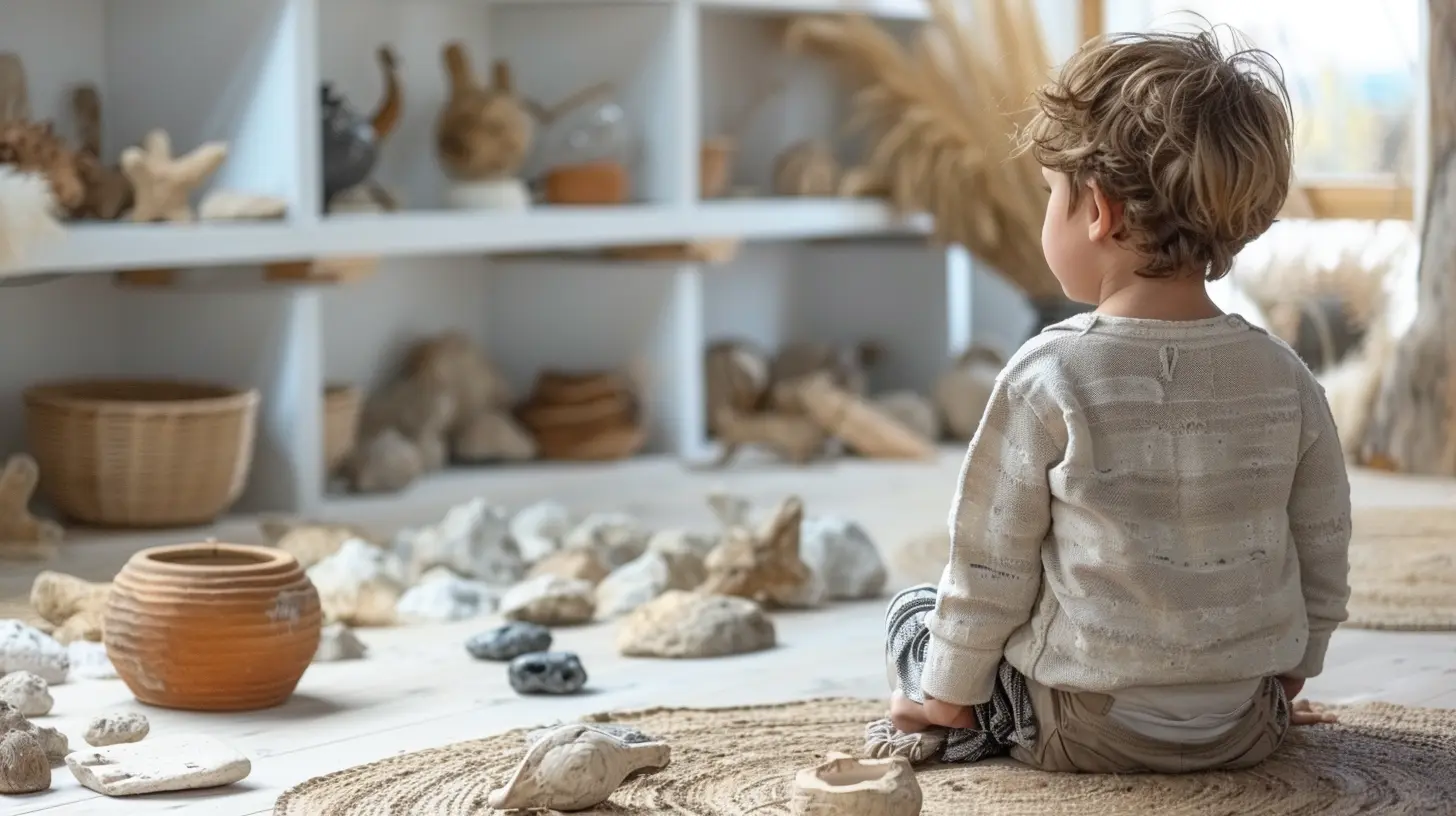Encouraging Independent Play Without Boredom
19 September 2025
As parents, we've all been there — the moment you finally sit down with a hot cup of coffee, only to hear, “Mom, I’m bored!” or “Dad, come play with me!” You love your kids with all your heart, but let’s be real — you also need five minutes to breathe, shower, or answer that work email without a Lego tower being smashed on your laptop.
Encouraging independent play isn’t about neglecting your child. It’s about giving them the tools and confidence to explore, imagine, and create without needing constant direction or entertainment. And no, it’s not impossible to do this without boredom setting in. In fact, with the right approach, independent play can become your child’s favorite part of the day (and your secret sanity-saver).
So, how do you get your kids to play independently without them complaining about being bored after five minutes? Pull up a chair, grab that lukewarm coffee, and let’s dive in.
Why Independent Play Matters (More Than You Think)
Before we jump into strategies, let’s talk about why independent play is so important — and why it’s not just a parenting convenience.Here’s what independent play does:
- Boosts creativity and imagination: When kids play on their own, their minds wander. They invent stories, assign roles to toys, and even mimic real-life situations.
- Builds confidence: Solving problems without adult help builds a powerful sense of autonomy.
- Improves focus and patience: Independent play teaches kids how to stay engaged and work through boredom without relying on external stimulation.
- Gives parents a break: Yes, you matter too. Time to yourself can recharge your parenting batteries.
So yeah, it’s not just “busy work” — it’s developmental gold.
The Misunderstood B-Word: Boredom
We often rush to fix boredom like it’s a bad thing. But here’s the kicker: some boredom is actually good. It's the gateway to creativity. Think of it like standing in front of a blank canvas — intimidating at first, but bursting with potential.Instead of trying to prevent all boredom, teach your kids to lean into it. That’s where the magic starts.
Step-By-Step: Nurturing Independent Play Without Whining or Boredom
Let’s break this down into age-appropriate, practical steps. Whether your child is a toddler magnetized to your leg or a school-ager craving constant stimulation, we've got you covered.1. Set the Stage: Create a Yes-Friendly Play Zone
Before your child even picks up a toy, their environment matters.What to do:
- Create a space where your child feels safe and free to explore. You want a zone where they can touch, climb, and move without constant “no”s.
- Keep toys accessible. Open baskets or low shelves are way better than toy chests where everything is jumbled together.
- Rotate toys weekly to keep things fresh without spending a dime. It’s like shopping in their own closet!
Why it works: Autonomy is easier when kids aren’t constantly needing help or permission.
2. Choose the Right Toys: Less is More
You don’t need a thousand toys — just the right ones.Go for toys that are:
- Open-ended (like blocks, dolls, or art supplies)
- Age-appropriate (so they don’t get frustrated)
- Low-tech (hello, imagination!)
Avoid toys that do all the work — flashing lights and talking robots are fun for five minutes but don’t leave room for imagination.
Pro tip: If your child gets bored easily, it might not be them — it might be the toy.
3. Start Small: Build the Independent Play Muscle
If your child is used to you being their play partner 24/7, going solo might feel weird at first. Totally normal.Here’s how to ease into it:
- Begin with just 5 to 10 minutes of independent play right next to you.
- Gradually increase the time as they get more comfortable.
- Use a timer to give them a visual cue — “Can you play by yourself until the timer dings?”
Celebrate after! Make a big deal out of it. "You played all by yourself for 10 minutes? That’s awesome!"
4. Set Expectations and Make It Routine
Kids thrive on structure. Let them know when it’s solo playtime and what it means.Example: “After snack time is your independent play time. You’ll use your imagination while I finish some work.”
Bonus Tip: You can even name it something cool like "Adventure Time" or "Imagination Hour" to make it sound exciting.
5. Give Them Control (Within Limits)
Wanna know a secret? Kids are more likely to do something when they feel like it was their idea.How to do it:
- Let them pick which toys to rotate in this week.
- Offer choices: “Do you want to play with blocks or color today?”
- Let them set the timer (with help, of course).
Why it matters: Autonomy fuels engagement. If they choose it, they’re more likely to stick with it.
6. Be Strategic with Your Attention
Here’s a simple truth: Kids will play independently as long as you don’t keep interrupting them.If you hover, comment on what they’re doing, or jump in too much, their brain switches back into “Mommy/Daddy’s playtime mode.”
What to do instead:
- Be a ninja. Observe from the background.
- When they call for help, wait a few seconds before responding. If they solve the problem on their own, awesome!
- Praise after the play session, not during.
7. Turn Boredom into a Superpower
Remember, boredom isn’t the enemy — dependency on constant stimulation is.When your child moans “I’m bored,” don’t rush in with a solution. Instead, help them brainstorm.
Try this:
- Ask, “What could you do with your toy animals right now?”
- Or, “What kind of drawings haven’t you done yet?”
- Give them a "Boredom Jar" filled with simple play ideas they can pick from.
Let them be part of the solution. Eventually, they’ll realize they can entertain themselves — and that’s a game-changer.
8. Model Independent Time
Yep, kids watch everything — including how you spend your time.If you want your child to play alone, show them that it’s okay to do things by yourself. Read a book. Do yoga. Sketch. Say out loud, “I’m doing something by myself right now, and it feels good.”
Monkey see, monkey do. Before you know it, they’ll mirror your behavior.
9. Be Patient (Seriously)
Building independent play habits isn’t a light switch — it’s a dimmer.There will be days they ask for more help, need more attention, or just aren’t feeling it. That’s okay. You’re not failing, and they’re not broken.
The key is consistency. Keep creating opportunities, keep encouraging, and trust the process. Independence, like any muscle, gets stronger with use.
Age-Specific Tips for Independent Play
Because a 2-year-old and a 7-year-old are in very different worlds, here’s a quick cheat sheet.Toddlers (1–3 years)
- Stick to simple toys: stacking cups, chunky puzzles, sensory bins.- Play nearby at first (“parallel play”).
- Keep sessions short — 5 to 10 minutes is a win.
Preschoolers (3–5 years)
- Add more storytelling play: dolls, action figures, dress-up.- Use themed play kits (farm, kitchen, doctor).
- Encourage role-playing and make-believe.
Early Elementary (6–8 years)
- Offer creative challenges: build a zoo, invent a new superhero.- Provide activity books, Legos, art supplies.
- Start encouraging solo reading or journaling.
Real Talk: You’re Not “Lazy” For Wanting Independent Play
Some parents feel guilty encouraging solo play — like they should be constantly entertaining their child. That’s a myth worth tossing in the trash.Independent play isn’t about ditching your kid. It’s about helping them grow into confident, creative, problem-solving little humans. And yes, it helps you stay sane and get stuff done. That’s not selfish; that’s smart parenting.
So the next time your kid gets lost in their own little world of knights, castles, or make-believe bakeries — take a deep breath and smile. You’re doing awesome.
Wrap-Up: The Sweet Spot Between Freedom and Fun
Encouraging independent play without boredom isn’t some magical unicorn dream. With the right setup, the right mindset, and plenty of patience, your child will not only embrace solo playtime — they’ll thrive in it.And who knows? You might just find that hot cup of coffee actually stays hot for once.
all images in this post were generated using AI tools
Category:
Parenting TipsAuthor:

Kelly Snow
Discussion
rate this article
1 comments
Kova Beck
What a wonderful article! Encouraging independent play is such a vital skill for our little ones. Your tips are practical and engaging, making it easy for parents to foster creativity and confidence in their children. Thank you!
September 27, 2025 at 4:11 AM

Kelly Snow
Thank you so much for your kind words! I'm glad you found the tips helpful for fostering creativity and confidence in children. Happy playing!


